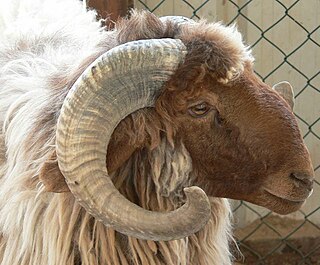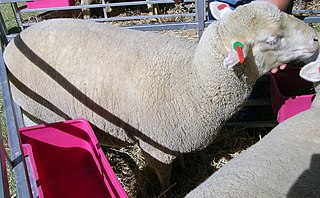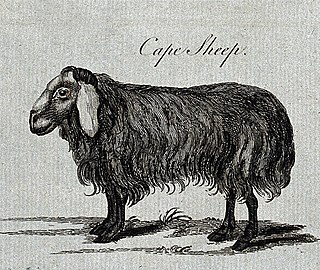
A herding dog, also known as a stock dog or working dog, is a type of dog that either has been trained in herding livestock or belongs to one of the breeds that were developed for herding. A dog specifically trained to herd sheep is known as a sheep dog or shepherd dog, and one trained to herd cattle is known as a cattle dog or cow dog.
The Damara is a Namibian breed of fat-tailed hair sheep, also found in South Africa. The name derives from that of the Damara region of northern Namibia where it is principally found, particularly in the Kaokoveld Desert. Together with the Namaqua Afrikaner and the Ronderib Afrikaner, it is one of three breeds in the Afrikaner group of sheep that were already in southern Africa before the arrival of colonists, and which forms part of the broader African Long-fat-tailed sheep grouping. It may be solid black, brown or white, or black-and-white pied.

The Border Leicester is a British breed of sheep. It is a polled, long-wool sheep and is considered a dual-purpose breed as it is reared both for meat and for wool. It is known for its distinctive upright ears. The sheep are large but docile. They have been exported to other sheep-producing regions, including Australia and the United States.

The Jacob is a British breed of domestic sheep. It combines two characteristics unusual in sheep: it is piebald—dark-coloured with areas of white wool—and it is often polycerate or multi-horned. It most commonly has four horns. The origin of the breed is not known; broken-coloured polycerate sheep were present in England by the middle of the seventeenth century, and were widespread a century later. A breed society was formed in 1969, and a flock book was published from 1972.

The Shropshire breed of domestic sheep originated from the hills of Shropshire, and North Staffordshire, England, during the 1840s. The breeders in the area used the local horned black-faced sheep and crossed them with a few breeds of white-faced sheep. This produced a medium-sized polled (hornless) sheep that produced good wool and meat. In 1855 the first Shropshires were imported into the United States (Virginia). This breed is raised primarily for meat.

The Spælsau is a breed of sheep from Norway. Many consider Spælsau to be the original breed of sheep in Norway, and it is one of the Northern European short-tailed sheep breeds. It is well adapted to the climate and was a domestic animal from the Iron Age. The spælsau stock is about 22% of the sheep in Norway.

The fat-tailed sheep is a general type of domestic sheep known for their distinctive large tails and hindquarters. Fat-tailed sheep breeds comprise approximately 25% of the world's sheep population, and are commonly found in northern parts of Africa, the Middle East, and various Central Asian countries, Afghanistan, Pakistan and all the way to China. The tail fat from those sheep is an important ingredient in many regional cuisines.

The Awassi is a breed of dairy sheep of Near-Eastern fat-tailed type. It is the most widely distributed non-European dairy breed. It is known by many names, among them Arab, Baladi, Deiri, Gezirieh, Ivesi, Shami and Syrian. It is usually white with brown head and legs.

The Romney, formerly called the Romney Marsh sheep but generally referred to by the local farmers as the Kent, is a breed of sheep originating in England. The Romney is a "long-wool" breed recognized in England by 1800. Exported to other continents, the Romney is an economically important sheep breed, especially to the sheep-meat and wool export trades of New Zealand.

The Katahdin is a modern American breed of sheep. It is an easy-care sheep: it grows a hair coat with little wool which moults naturally in the spring, and so does not need to be shorn. It is reared for meat only.

The Shetland is a small, wool-producing breed of sheep originating in the Shetland Isles, Scotland, but is now also kept in many other parts of the world. It is part of the Northern European short-tailed sheep group, and it is closely related to the extinct Scottish Dunface. Shetlands are classified as a landrace or "unimproved" breed. This breed is kept for its very fine wool, for meat, and for conservation grazing.

The St Croix is a breed of domestic sheep native to the U.S. Virgin Islands and named for the island of Saint Croix. They are often also called Virgin Island White because those that were imported into North America were selected for white coloration. On the Island of St. Croix, they come in shades of brown, white, and black.

The Poll Dorset, a short-wool, meat-producing sheep, was developed in Australia between 1937 and 1954 with the aim of breeding a true Dorset type sheep without horns. The poll gene was introduced into Dorset Horn flocks from two other polled breeds and following a strict back-mating programme achieved close to 100% of Dorset Horn blood. Its main distinguishing features are its hornless appearance, long, lean square body set on short legs, pink skin and 'spongy' short-stapled wool. The Poll Dorset produces a fleece of white, dense downs type wool of 30 microns fibre diameter and it has a white wool-free face. The breed was first developed by WJ Dawkins at his property, Newbold, Gawler River ,SA. commencing in 1937 using Corriedales to introduce the poll gene. In 1941, Lyall Stuart from Valmore in Whitemore, Tasmania and in1943, Rex Wilson from Kismet in Howlong, NSW both used Ryelands to introduce the poll gene. into the Dorset Horn. In 1954 these three men and Jack Reddin form Newbold, founded the Australian Poll Dorset Association.

The Charollais is a breed of domestic sheep originating in east central France, in the same region in which Charolais cattle originated, Charolles and Saône-et-Loire. It is known for ease of lambing and is used as a terminal sire to increase muscling and growth rate of the lambs. It has been exported internationally, and is commonly used in the United Kingdom as a sire to produce market lambs from pure-bred ewes and mules.

The Blackhead somali sheep is a fat-tailed breed of domestic sheep from Africa. The sheep is originally from Somalia and a direct descendant of the Somali sheep. The breed is also a type of hair sheep, meaning they do not grow wool and tolerate heat better than wooled breeds and are raised primarily for meat. The Blackhead Persian has a white body and, as their name would suggest, an entirely black head.

Sheep or domestic sheep are a domesticated, ruminant mammal typically kept as livestock. Although the term sheep can apply to other species in the genus Ovis, in everyday usage it almost always refers to domesticated sheep. Like all ruminants, sheep are members of the order Artiodactyla, the even-toed ungulates. Numbering a little over one billion, domestic sheep are also the most numerous species of sheep. An adult female is referred to as a ewe, an intact male as a ram, occasionally a tup, a castrated male as a wether, and a young sheep as a lamb.

The South African Meat Merino or SAMM is a wool and meat sheep originating in South Africa, but now found throughout the world.

Sheep are among the first animals to have been domesticated by humans. Their history goes back to between 11,000 and 9,000 BCE, when humans domesticated the wild mouflon in ancient Mesopotamia. The first sheep were primarily raised for meat, milk, and skins. Woolly sheep began to be developed around 6000 BCE. They were then imported to Africa and Europe via trading.

The Red Maasai is a breed of sheep indigenous to East Africa. True to its name, the breed is kept by the Maasai, though both pastoralists and smallholder farmers in Kenya, Tanzania, and Uganda keep Red Maasai flocks.

The Afrikaner sheep or Cape Fat-tailed is a breed of fat tailed, hair sheep indigenous to South Africa.



















